Ribes missouriense
|
|
|
|
Family: Grossulariaceae
Missouri Gooseberry
|
Plants 1.3-2 m. Stems erect to sprawling, glabrous or puberulent; spines at nodes sometimes absent or 1-3, 7-18 mm; prickles on internodes absent or scattered. Leaves: petiole 0.7-2 cm, hairy, with longer and often plumose hairs and elongated glands near base, short-stipitate glands absent; blade roundish, 3-lobed, cleft nearly to midrib, 1.7-3 cm, base broadly cuneate to rounded or subcordate, sometimes truncate, surfaces not glandular, villous-tomentose abaxially, puberulent to hirsute, glabrescent adaxially, lobes straight-sided to sometimes cuneate, margins toothed, apex rounded. Inflorescences pendent, solitary flowers or 2-4-flowered corymbs, 3-5 cm, axis glabrous or sparsely lanate to pilose and puberulent, sparingly stipitate-glandular, flowers evenly spaced. Pedicels not jointed, 5-13 mm, glabrous; bracts broadly ovate, 2-2.5 mm, ciliate. Flowers: hypanthium greenish white, narrowly tubular, 1.5-2.5 mm, glabrous; sepals not overlapping, spreading to reflexed, pale green to white, linear-oblong, 5-7 mm; petals connivent, erect, pale green to nearly white, becoming pink tinged, cuneate-obovate, not conspicuously revolute or inrolled, 2-3.5 mm; nectary disc not prominent; stamens 3-5 times as long as petals; filaments linear, 15 mm, glabrous; anthers cream to pale pink, oblong-sagittate, 2 mm, apex rounded; ovary glabrous; styles connate nearly 7/8 their lengths, 10-14 mm, glabrous. Berries palatable, red to purple, globose, 7-12 mm, glabrous. 2n = 16. Flowering Apr-Jun. Upland woods, thickets, prairie ravines, pastures; 0-600 m; Ont.; Ark., Conn., Ill., Ind., Iowa, Kans., Ky., Md., Minn., Mo., Nebr., N.J., N.Dak., Ohio, Okla., Pa., S.Dak., Tenn., Va., W.Va., Wis. In Ribes missouriense and some other species (e.g., R. americanum, R. cynosbati, R. oxyacanthoides), the filaments are attached in a 'pocket' of the anthers; the anthers have a sagittate appearance although the bases do not spread away from the main axis (A. F. Cholewa, pers. comm.). In the Midwest, Ribes missouriense often is an indicator of woodlands that have experienced grazing pressure (G. Yatskievych, pers. comm.). The eastern North American populations in Connecticut, Maryland, New Jersey, Pennsylvania, Virginia, and West Virginia are probably escapes from cultivation.
Shrub to 2 m tall Leaves: alternate, stalked, 1.5 - 3.5 cm long, 2 - 6 cm wide, palmately three- to five-lobed, rounded with a broadly flattened to somewhat heart-shaped base, palmately veined, coarsely toothed, sometimes softly hairy (at least beneath). Inflorescence: a small cluster of two to three flowers. Branches slender, 1 - 2 cm long, mostly exceeding the flower stalks, minutely hairy or glandular to nearly hairless. Flowers: white to greenish white. Stalk 0.5 - 1.3 cm long, subtended by short bracts that bear a marginal fringe of hairs. Stamens five, 0.9 - 1.5 cm long, becoming longer than calyx lobes. Styles two, divided, 1 - 1.4 cm long. Sepals: forming a five-lobed tube (calyx). Calyx white to greenish white and hairy. Lobes reflexed, as long or longer than tube, linear, sometimes hairy. Petals: five, in the throat of the calyx tube, white to pinkish, 2 - 3.5 mm long, reverse egg-shaped with a tapering base, alternate with calyx lobes. Fruit: a juicy berry, many-seeded, crowned by the shriveled calyx, red to purplish, 1 - 1.5 cm wide, smooth. Branches: grayish or whitish, with stout, reddish spines up to 2 cm long. Similar species: The similar Ribes cynosbati differs by having prickly berries and calyx lobes that are shorter than the tube. Ribes hirtellum is also similar but has greenish yellow or pale purple flowers and berries that are 8 - 10 mm wide. Flowering: late March to late May Habitat and ecology: This somewhat weedy shrub is very common in woods, especially in areas that have been grazed or abused otherwise. Occurence in the Chicago region: native Etymology: Ribes comes from the Arabic name for a shrub that has acidic fruit. Missouriense means "of or from Missouri." Author: The Morton Arboretum Nodal spines stout; lvs 1.5-3.5 cm, rotund in outline, the 2 principal sinuses extending nearly to the middle, softly hairy at least beneath, or glabrate in age; peduncles puberulent or glandular to subglabrous, 1-2 cm, mostly much exceeding the 5-13 mm pedicels; floral bracts ciliate with glandular and eglandular hairs; ovary and fr glabrous; hypanthium 1.5-2.5 mm, cupulate, white or creamy; sep oblanceolate, 5-7.5 mm, reflexed; pet cuneate-obovate, white (or pinkish in age), 2-3.5 mm; stamens 9-12 mm; style 10-14 mm, bifid; fr red to purple; 2n=16. Moist or dry upland woods; Ind. to Minn. and Tenn., w. to Mont. and Kans. May. Gleason, Henry A. & Cronquist, Arthur J. 1991. Manual of vascular plants of northeastern United States and adjacent Canada. lxxv + 910 pp. ©The New York Botanical Garden. All rights reserved. Used by permission. From Flora of Indiana (1940) by Charles C. Deam This species has been reported from Hamilton, Kosciusko, Lake, Marion, St. Joseph, and Tippecanoe Counties. In the herbarium of DePauw University there are specimens from Jasper, Putnam, and Vigo Counties. My specimens are mostly from the central and western counties where I found them in dry soil, usually on the bluffs of streams. The Henry County specimen was found in a dry woods and the one from Tippecanoe County was found with skunkcabbage in a springy place. …… Indiana Coefficient of Conservatism: C = 3 Wetland Indicator Status: N/A |
|
|
|



























































































